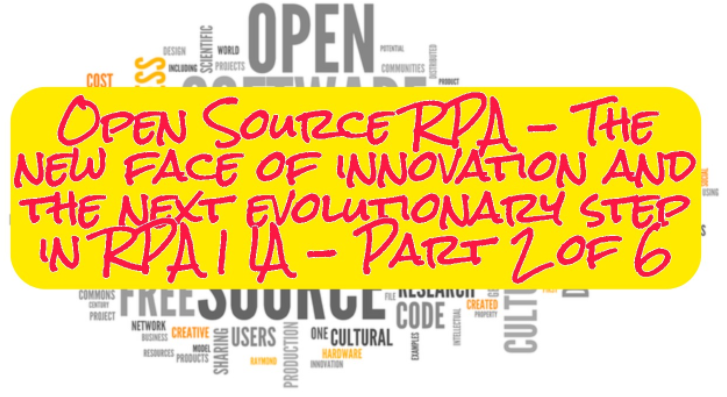Q is for QBR | Quality | Quit | Quantify | Queue | Question | Qualify | Queen Bee | Quantity | Q&A | Quest
Welcome to the SEVENTEENTH part of a 26 part series detailing the A-Z of all things Robotic Process Automation (RPA), Data Analytics (DA), Intelligent Automation (IA) and Digital Transformation (DT). This article highlights all things relating to intelligent automation and digital transformation beginning with the letter ‘Q’.
Question – (to your supplier). There are a great many automation platforms to choose from. Each platform is different. But one thing remains the same. It is not the platform, nor the number of robots you have purchased that guarantees success. Rather, it is the ROI businesses gain from their investment that counts (i.e. their ROI from an automation program).
“It’s very odd how – faced with an overwhelmingly compelling business (on some occasions 10’s of millions in benefits against tens of thousands of cost) clients and prospects still push for further software or consulting rate discounts. Looking at the WRONG side of the equation is NOT the way to exploit the power of Intelligent Automation. Therefore, when an organisation is engaging with a vendor don’t focus solely on how many people the vendor employs nor how many bots they have sold (Caveat Emptor!). Instead, focus on what their client organisations have achieved in terms of ROI | Transformation and how they have helped clients achieve that ROI.”
Nick Andrews, Executive Chairman Virtual Operations Global Advisory Board
- 40 Essential Criteria To Choose an RPA Platform (Author)
- The biggest lie to RPA customers – 50 Robots Equals Success (Author)
“True faith requires doubt. Never forget to question your projects for motives, financials and outcomes. But the most important question should always be: am I optimising with the right tool? Right tool questions should always factor in these considerations:
– Speed of deployment of other solutions and required urgency
– Cost of deployment of other solutions and budget
– Quality of other solutions and your enterprise architecture
For a Head of RPA, RPA can seem the right tool for everything. But really, we are not on this planet to sell a specific software – we are here for the good of mankind. So let us all agree to always think (if not that big then) a bit bigger”.
Lasse Rindom Automation Technology Manager
Queen Bee: Look for the “Queen bee” (customer) in the process. What’s the Queen’s purpose? What’s the purpose of the Bee Hive (the organisation that provides the service to the customer). Why is the Queen being fed? How is the Queen fed? Does she call upon you due to hunger? What’s the Queen’s role? What’s the hive’s role? and what’s the role of the worker bees? Is the Queen behaving the way she is supposed to? Why is she not behaving according to the laws of the hive (the process that the organisation expects the customers to follow)? What do the worker bees do? How do they do it? What’s the quality of the Honey being produced? Question the Bee Hive and the citizens of the Bee Hive.
Rajesh Nair, Serial Process Thinker, Design Thinking and Automaton
Qualified – There are ‘so called’ paper certified Robotic Process Automation developers, there are ‘citizen developers’ and then there are ‘truly exceptional’ RPA developers. Get this role right and you have the foundations you need to succeed. Get this role wrong and you have built your intelligent automation foundations on sand. Possessing qualifications is no guaranteed sign of being a success in any industry or professions.
“Qualified practitioners – from Business Analysts to Developers and Infrastructure Engineers – play a key role in enhancing the knowledge and credibility of an organisation’s Centre of Excellence. However, building the right capability requires more than qualifications alone. Exceptional practitioners also bring extensive real world experience and a true innate passion which drives them day in, day out to improve. Additionally, they realise, even the more technically inclined, that the ultimate purpose is to execute their role in a way that helps realise value for the organisation, its customers and society as a whole.”
Lewis Walker, Intelligent Automation Architect
But qualifications can, to some degree, be considered an indicator of understanding. When assessing individuals and partner organisations for your automation program ask after their qualifications. But do remember to ask how many years of real automation experience does they bring too.
“As someone that hasn’t gained a qualification since High School, presumably I’m not actually “Qualified” to discuss the merits or not of qualifications in the Automation space. That said, I’d take a solid thinker, and problem solver who can demonstrate capability both mental and technical without a qualification vs someone that has all the certificates under the sun but can not convince me they have the right capabilities in a conversation.
Are qualifications important? Yes. Are they everything in this space? My own experience would say, certainly not. Having both demonstrable capabilities, experience and certification is the goal for all in this space that wish to go far. (I better get studying myself to then!)”
Wayne Butterfield, Automation Expert
Quarterly Business Review (QBR) – Digital and automation programs need to make money in excess of cost of capital. Otherwise they have failed. Teams are often very optimistic about the returns they will achieve from their automation programs but neglect to regularly check to see if program returns materialise. Reviewing the costs and benefits of a program each quarter will help organisations keep count. Anything that stops delivering benefit should be stopped.
- If your RPA program is not making money then it has failed.
- 22 ways to save money when delivering an automation program
Quality (data) – Excellent quality data is needed to train and run an analytics model. There are a great many analytics models that can be used to create insight and value but models need excellent quality data to work (e.g. retention, cross-sell, up-sell, next best action analytics). But all rely on data. Data must be captured and curated to glean exceptional insights. Therefore, an organisation must have a data strategy that has an excellent data governance program attached.
“Quality of Data is your Queen in your Intelligence journey Success, There is a common saying “Garbage in, Garbage out” so if your data is poor, the decisions will be equally poor. Data Quality not only about being clean but also to be historical, uniform, simple, and Lineage”
Sarah Ghanem, Intelligent Automation Consultant & Trainer
Questions and Answers: One very easy way to deflect calls from your contact centre, is to add a simple question and answers section on a company website. To develop an effective Q&A section organisations need to listen to 100 customer calls to work out what customers want solved. Too often, organisations put FAQs online that they choose. This this often proves very different to what customers actually want. Organisations also need to tell customers that an FAQ site section exists at every opportunity rather than hoping customers will work this out e.g. in their letters, IVR, agent conversations, etc.
“Q&A is a tried and trusted technique to Queue bust when there is a common query that needs to be answered. If you’ve been on the receiving end of a generic script that doesn’t quite answer your specific nuance of a question then they can cause frustration as well as still leading to a manned contact being needed. Key is to ensure that you chose the right questions to answer in this manner, such as opening hours (just make sure you update them if they change for things like Bank Holidays) For anything that could have multiple answers, you are always best to look at ways you can tailor your answer to the specific customer, you may then see Q&A containment of upwards of 70%.”
Wayne Butterfield, Automation Expert
Qualify – rather than accept every automation idea found or presented, an automation centre or expertise | governance process should qualify every opportunity presented to it. A strict score card of measures should be set and never deviated. Not every process is suitable for automation e.g. brittle process, human judgement required, key moment of truth in a suitableness relationship that demands a conversation, cost too must to support, etc.
- 8 questions to ask to ensure you select the ‘right’ processes to automate using RPA | IA.
- 30 ways to build a pipeline of processes suitable for Robotic Process Automation (RPA) and Intelligent Automation (IA) and make money
“Though automation has proved its existence it is not a silver bullet. The best RPA developers evaluate as a minimum the following items: ROI; Data input quality; if the underlying business process is healthy and creates value for the business; if the employees managing the process saves time and hassle. Sometimes the best solution is not to automate.”
Nina Barfoed Petersen, Head of Robotics
Quest: Even though you might only be killing bandits on the outskirts of a small village somewhere in Hobbit land, always plan and build your character to stand the test of the final villain, and prevail. I always choose a magic character when playing RPG PC games for this same reason: while reloading in the first couple of levels, I know I will be a bad-ass fireball wielding maniac in later levels. To get there, though, I have to carefully consider my attributes, traits and abilities. Likewise with any business program – and automation. Is your current way of operating good enough to be adapted by the whole organisation (and other countries)? Will your current benefits end up being your bottleneck in a year? Define your final quest and build toward it at all time – no matter what stakeholders may say.
Lasse Rindom Automation Technology Manager
“We live in a time of uncertainty and change. However, one thing is certain, and that is change. The pace of change in Automation is accelerating rapidly and the body shops and snake oil reps will not be able to keep up. Take your time to find the right platform partner; on with the right products, services and ‘accredited’ people for your automation journey. Avoid the over promising, commission dependent sale person who is only interested in themselves. Find the right partner and work with them. The best relationships are win-win relationships.”
Nick Andrews, Executive Chairman Virtual Operations Global Advisory Board
Queue Management. Robot licences can cost a lot of money. To maximise the value from your robot licences, it is essential to manage bot queues effectively. Enabling bots to run for as long as possible without human intervention should result in lower run the business maintenance costs and better returns from bots.
“Queue management is essential for organisations pursuing large-scale automation. It helps processes run concurrently on multiple machines, subdivide into a series of tasks for resilience, and optimise license utilisation. In addition, it aids monitoring to satisfy service-level agreements, and reporting for effective decision making – both business and operational. More complex queue designs include multiple-part processes, parent/child relationships, human-in-the-loop, workflow system triggers, and real-time work requests. For years, advanced functionality has been at the heart of pioneering Robotic Process Automation vendors.”
Lewis Walker, Intelligent Automation Architect
Where humans are employed to work 8 hours per day, only 5.5 hours is actually worked (minus lunch, sick, holiday, lunch, breaks, bathroom, training, etc.) Robots can work at 100 capacity 20-24 hours per day. Therefore, the more effectively organisations manage their robot workforce the better.
“Queue management is costly both in terms of time and also inefficiency if managed poorly as organisations scale. Robots downtime between different processes / tasks etc. is lost productivity. Your silicon workers are similar to your contact centre employees. You’d usually staff to demand, you don’t really want to have idle time (not a lot of it at least), and your Automation queues are exactly the same.
Idle robot time is bad. I tis good bot queue management, via exceptional planning or specific technologies, that help make your bots be as efficient as possible by reducing bot idle time to a minimum. Don’t tell the vendors, but you might be able to squeeze upwards of 30% more capacity out your Bots with better queue management 😉”
Wayne Butterfield, Automation Expert
Queue of processes. Automation programs often fail to gain momentum after an exciting Proof of Concept as teams forget to build a follow on list of processes to automate. This skills program momentum or team motivation as everyone waits for something to do. The team and business lose interest, the program financial benefits don’t mount up as resources, time and attention are placed elsewhere. It takes time to find or redesign processes suitable for automation. Therefore, always have a strong queue of processes ready to go.
Quit. If you can’t make your automation program work then simply stop.
“Quit banging your head against the wall and automate the business process right in front of you. If you have LOB budget then skip the interminable haggling with IT, GBS, and the C-Level. Request a free turnkey POC and specify that it run securely within your existing domain. Shift all of the technical and reputation risk to the vendor and let them prove you right. If they can not do that for your project, walk away. If they can, congratulations.”
JD Wilson Jr, RPA Innovator and Founder
Don’t throw more good money after bad, no matter how much time, money and effort have gone into a program to date. Instead, take time out to reflect, learn from your mistakes and go again at a more opportune time.
“Quagmire – a place you will find yourself months after commencing an Automation Program without a clear strategy or plan. Make a plan, execute the plan, and stick to a plan!”
Nick Andrews, Executive Chairman Virtual Operations Global Advisory Board
Quality Assurance (QA) & Quality Control (QC) – What does this mean to you? It goes beyond checking the final results, but it should prompt the questions – is the Bot fit for purpose, does it conform to requirements, does it conform to the standards set by the robotic operating model, will it work? The history of QC dates as far back as the industrial revolution in the twenties. It embodied the technical and engineering qualities of a product and in the fifties, as production/processes matured, quality control expanded to include QA. This may sound foreign to some individuals, similarly, an RPA Bot is purely a product and in mass producing that product (scaling to 100’s of bots in production), QA and QC should form an integral part of the delivery. I tell people the following
- Perform ‘test’ rigs to quickly achieve a ‘fail-fast’ scenario in development to help build resiliency and recoverability
- Perform mandatory code reviews. It’s non-negotiable
- Seek advice on automated solutions from an expert, ideally someone from your Design Authority or an experienced solution designer/Architect
- Measure the effect of automation by constantly generating MI & continuously improve the solution
- Follow a proven delivery methodology. Go through your gatekeepers (control room, design authority, governance board), there is a reason they are there in the first place
- Prune your automation candidates. NOT ALL PROCESSES SHOULD BE AUTOMATED.
Tolani Jaiye-Tikolo, Hyperautation and Intelligent Automation Consultant
Quantity: Always remember that the key to professional is quantity. That you can do what you do good in all settings and across multiple scenarios and against hundreds of obstacles over the course of a whole career. In line with remembering your quest and moving toward it (above), always remember sturdiness and replicability in every project. You would want to be able to quantify and repeat the good things – and avoid the bad. In short – always try to conceptualise based on and for quantity and refine your ideal types to perfection.
Lasse Rindom Automation Technology Manager
This article highlighted some things relating to intelligent automation and digital transformation beginning with the letter “Q”. There are many ‘Q’s’ organisations need to consider but what ‘Q’ do you think is the most important?
#intelligentautomation #bots #rpaworks #digitaltransformation#roboticprocessautomation #rpa #cognitiveautomation #digitaldisruption#digitalworkforce #processautomation #digitalfuture #digitalstrategy
Other articles: If you like this article then you may find these articles of use also.
- How to build a business case for Intelligent Automation and Robotic Process Automation
- 30 ways to build a pipeline of processes suitable for Robotic Process Automation (RPA) and Intelligent Automation (IA)
- The biggest lie told to RPA customers – 50 robots equals success
- 40 essential selection criteria to choose an RPA platform
If this could benefit someone else tag them and share this.
Free to reuse: We are a community of RPA, digital analytics, digital transformation and Intelligent Automation experts with years of real world experience. We have stories to tell and the scars to show for it. We share our collective wisdom for free to simply provide as much value as we can to you. Therefore, if you want to post this article on your LinkedIn page then please feel free to do so. The more information we share within the RPA community the more likely businesses are to succeed with this excellent technology.
Further Help: If I can help you in any way please do reach out.
Note: The views expressed above are our views and not those of my employer or the employers of the contributing experts.










Leave a Reply